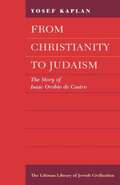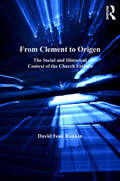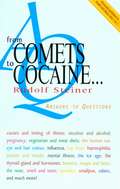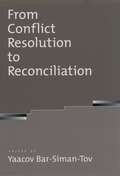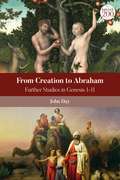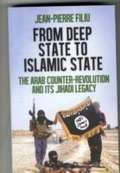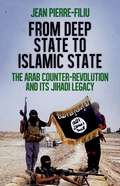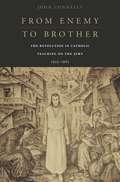- Table View
- List View
From Christian Science to Jewish Science: Spiritual Healing and American Jews
by Ellen M. UmanskyDuring the late nineteenth and early twentieth centuries, thousands of American Jews were drawn to the teachings of Christian Science. Viewing such attraction with alarm, American Reform Rabbis sought to counter Christian Science's appeal by formulating a Jewish vision of happiness and health. Unlike Christian Science, it acknowledged the benefits of modern medicine yet, sharing the belief in God as the true source of healing, similarly emphasized the power of visualization and affirmative prayer. Though the numbers of those formally affiliated with Jewish would remain small, its emphasis on the connection between mind and body influenced scores of rabbis and thousands if not hundreds of thousands of American Jews, predating contemporary Jewish interest in spiritual healing by more than seventy years. Examining an important and previously unwritten chapter in the story of American Judaism, this book sheds light on religious and social concerns of twentieth-century American Jewry, including ways in which adherence to Jewish Science helped thousands bridge the perceived gap between Judaism and modernity.
From Christian Science to Jewish Science: Spiritual Healing and American Jews
by Ellen M. UmanskyDuring the late nineteenth and early twentieth centuries, thousands of American Jews were drawn to the teachings of Christian Science. Viewing such attraction with alarm, American Reform Rabbis sought to counter Christian Science's appeal by formulating a Jewish vision of happiness and health. Unlike Christian Science, it acknowledged the benefits of modern medicine yet, sharing the belief in God as the true source of healing, similarly emphasized the power of visualization and affirmative prayer. Though the numbers of those formally affiliated with Jewish would remain small, its emphasis on the connection between mind and body influenced scores of rabbis and thousands if not hundreds of thousands of American Jews, predating contemporary Jewish interest in spiritual healing by more than seventy years. Examining an important and previously unwritten chapter in the story of American Judaism, this book sheds light on religious and social concerns of twentieth-century American Jewry, including ways in which adherence to Jewish Science helped thousands bridge the perceived gap between Judaism and modernity.
From Christianity to Judaism: Story of Isaac Orobio de Castro (The Littman Library of Jewish Civilization)
by Yosef KaplanIsaac Orobio de Castro, a crypto-Jew from Portugal, was one of the most prominent intellectual figures of the Sephardi Diaspora in the seventeenth century. After studying medicine and theology in Spain, and having pursued a distinguished medical career, he was arrested by the Spanish Inquisition for practising Judaism, tortured, tired, and imprisoned. He subsequently emigrated to France and became a professor of medicine at the University of Toulouse before openly professing his Judaism and going to Amsterdam where he joined the thriving Portuguese Jewish community. Amsterdam was then a city of great cultural creativity and religious pluralism where Orobio found open to him the world of religious thinkers and learned scholars. In this atmosphere he flourished and became an outstanding spokesman and apologist for the Jewish community. He engaged in controversy with Juan de Prado and Baruch Spinoza, who were both excommunicated by the Portuguese Jewish community, as well as with Christian theologians of various sects and denominations, including Philip van Limborch. This fascinating biography of Orobio sheds light on the complex life of a unique Jewish community of former Christians who had openly returned to Judaism. It focuses on the particular dilemmas of the converts, their attempts to establish boundaries between their Christian past and their new identity, their internal conflicts, and their ability to create new forms of Jewish life and expression.
From Christianity to Spiritualism (Routledge Revivals)
by Charles Thomas CampionFirst published in 1935, From Christianity to Spiritualism provides a critical overview of Christian faith in relation to spirituality. It discusses themes like religion and worldview; the Bible old and new; Jesus and Paul; from Jesus to Christ; and spiritualism and values.The author says that a great deal has been written by spiritualists about the Bible as being a book full of happenings which are evidently psychic, and which therefore provides support for the belief that spiritualism is true and valuable today as it undoubtedly was in Bible times. The tendency of critical theology has, of course, always been to diminish the miraculous or supernormal elements in the Bible, and spiritualist explanations have rendered that process easier and more thorough. This is an interesting read for students of religion.
From Christianity to Spiritualism (Routledge Revivals)
by Charles Thomas CampionFirst published in 1935, From Christianity to Spiritualism provides a critical overview of Christian faith in relation to spirituality. It discusses themes like religion and worldview; the Bible old and new; Jesus and Paul; from Jesus to Christ; and spiritualism and values.The author says that a great deal has been written by spiritualists about the Bible as being a book full of happenings which are evidently psychic, and which therefore provides support for the belief that spiritualism is true and valuable today as it undoubtedly was in Bible times. The tendency of critical theology has, of course, always been to diminish the miraculous or supernormal elements in the Bible, and spiritualist explanations have rendered that process easier and more thorough. This is an interesting read for students of religion.
From Clement to Origen: The Social and Historical Context of the Church Fathers
by David Ivan RankinFrom Clement to Origen addresses the engagement of a number of pre-Nicene Church Fathers with the surrounding culture. David Rankin considers the historical and social context of the Fathers, grouped in cities and regions, their writings and theological reflections, and discusses how the particular engagement of each with major aspects of the surrounding culture influences, informs and shapes their thought and the articulation of that thought. The social and historical context of the Church Fathers is explored with respect to the Roman state, the imperial office and imperial cult, Greco-Roman class structures and the patron-client system, issues of wealth production and other commercial activity, the major philosophical thinkers in antiquity, and to rhetorical theory and practice and the higher learning of the day.
From Clement to Origen: The Social and Historical Context of the Church Fathers
by David Ivan RankinFrom Clement to Origen addresses the engagement of a number of pre-Nicene Church Fathers with the surrounding culture. David Rankin considers the historical and social context of the Fathers, grouped in cities and regions, their writings and theological reflections, and discusses how the particular engagement of each with major aspects of the surrounding culture influences, informs and shapes their thought and the articulation of that thought. The social and historical context of the Church Fathers is explored with respect to the Roman state, the imperial office and imperial cult, Greco-Roman class structures and the patron-client system, issues of wealth production and other commercial activity, the major philosophical thinkers in antiquity, and to rhetorical theory and practice and the higher learning of the day.
From Comets to Cocaine...: Answers to Questions
by Rudolf SteinerThe remarkable discussions in this volume took place between Rudolf Steiner and workers at the Goetheanum, Switzerland. The varied subject-matter was chosen by his audience at Rudolf Steiner's instigation. Steiner took their questions and usually gave immediate answers. The astonishing nature of these responses - their insight, knowledge and spiritual depth - is testimony to his outstanding ability as a spiritual initiate and profound thinker. Accessible, entertaining and stimulating, the records of these sessions will be a delight to anyone with an open mind. In this particular collection, Rudolf Steiner deals with topics ranging from comets to cocaine! He discusses, among other things, nicotine and alcohol; the causes and timing of illness; pregnancy; vegetarian and meat diets; the human ear, eye and hair colour; influenza, hay fever, haemophilia; planets and metals; mental illness; the ice age; the thyroid gland and hormones; beavers, wasps and bees; the nose, smell and taste; and jaundice, smallpox and rabies.
From Complexity to Life: On The Emergence of Life and Meaning
by Niels Henrik GregersenThis book brings together an impressive group of leading scholars in the sciences of complexity, and a few workers on the interface of science and religion, to explore the wider implications of complexity studies. It includes an introduction to complexity studies and explores the concept of information in physics and biology and various philosophical and religious perspectives. Chapter authors include Paul Davies, Greg Chaitin, Charles Bennett, Werner Loewenstein, Paul Dembski, Ian Stewart, Stuart Kauffman, Harold Morowitz, Arthur Peacocke, and Niels H. Gregersen.
From Conflict Resolution to Reconciliation
by Yaacov Bar-Siman-TovThis volume represents an important new step forward in the fields of conflict resolution and peace studies. Its essays argue that, while conflict resolution is well equipped to bring about temporary settlements and brief periods of peace in volatile situations, conventional conflict resolution techniques are not capable of building long-term stability. Instead, the authors contend, practitioners of conflict resolution need to focus more on reconciliation (the restoration of confidence, friendship, and harmony between rivals) than on mere conflict resolution. Whereas traditional conflict resolution has focused primarily on halting quarrels with agreements between leaders on each side of a conflict, reconciliation techniques shift the focus in two ways. First, they take more of a grassroots approach, building agreement among the members of rival communities, not only between leaders. Second, reconciliation takes a long-term view of dispute resolution. While the authors acknowledge that the role of traditional conflict resolution is important in stopping violence and tension, they argue that, in order to achieve stable peace, negotiators and practitioners of conflict resolution must focus much more on what is to be done after an agreement among leaders is reached.
From Conflict Resolution to Reconciliation
by YAACOV BAR-SIMAN-TOVThis volume represents an important new step forward in the fields of conflict resolution and peace studies. Its essays argue that, while conflict resolution is well equipped to bring about temporary settlements and brief periods of peace in volatile situations, conventional conflict resolution techniques are not capable of building long-term stability. Instead, the authors contend, practitioners of conflict resolution need to focus more on reconciliation (the restoration of confidence, friendship, and harmony between rivals) than on mere conflict resolution. Whereas traditional conflict resolution has focused primarily on halting quarrels with agreements between leaders on each side of a conflict, reconciliation techniques shift the focus in two ways. First, they take more of a grassroots approach, building agreement among the members of rival communities, not only between leaders. Second, reconciliation takes a long-term view of dispute resolution. While the authors acknowledge that the role of traditional conflict resolution is important in stopping violence and tension, they argue that, in order to achieve stable peace, negotiators and practitioners of conflict resolution must focus much more on what is to be done after an agreement among leaders is reached.
From Conventionalism to Social Authenticity: Heidegger’s Anyone and Contemporary Social Theory (Studies in the Philosophy of Sociality #10)
by Hans Bernhard Schmid Gerhard ThonhauserThis edited volume offers a new approach to understanding social conventions by way of Martin Heidegger. It connects the philosopher's conceptions of the anyone, everydayness, and authenticity with an analysis and critique of social normativity. Heidegger’s account of the anyone is ambiguous. Some see it as a good description of human sociality, others think of it as an important critique of modern mass society. This volume seeks to understand this ambiguity as reflecting the tension between the constitutive function of conventions for human action and the critical aspects of conformism. It argues that Heidegger’s anyone should neither be reduced to its pejorative nor its constitutive dimension. Rather, the concept could show how power and norms function.This volume would be of interest to scholars and students of philosophy and the social sciences who wish to investigate the social applications of the works of Martin Heidegger.
From Creation to Abraham: Further Studies in Genesis 1-11 (The Library of Hebrew Bible/Old Testament Studies)
by John DayJohn Day investigates disputed points of interpretation within Genesis 1-11, expanding on his earlier book From Creation to Babel with 11 stimulating essays. Day considers the texts within their Near Eastern contexts, and pays particular attention to the later history of interpretation and reception history.Topics covered include the meaning of the Bible's first verse and what immediately follows, as well as what it means that humanity is made in the image of God. Further chapters examine the Garden of Eden, the background and role of the serpent and the ambiguous role of Wisdom; the many problems of interpretation in the Cain and Abel story, as well as what gave rise to this story; how the Covenant with Noah and the Noachic commandments, though originally separate, became conflated in some later Jewish thought; and the location of 'Ur of the Chaldaeans', Abraham's alleged place of origin, and how this was later misinterpreted by Jewish, Christian and Islamic sources as referring to a 'fiery furnace of the Chaldaeans'. These chapters, which illuminate the meaning, background and subsequent interpretation of the Book of Genesis, pave the way for Day's forthcoming ICC commentary on Genesis 1-11.
From Creation to Babel: Studies in Genesis 1-11 (The Library of Hebrew Bible/Old Testament Studies #592)
by John DayThe stories of Genesis 1-11 constitute one of the better known parts of the Old Testament, but their precise meaning and background still provide many debated questions for the modern interpreter. In this stimulating, learned and readable collection of essays, which paves the way for his forthcoming ICC commentary on these chapters, John Day attempts to provide definitive solutions to some ofthese questions. Amongst the topics included are the background and interpretation of the seven-day Priestly Creation narrative, problems in the interpretation of the Garden of Eden story, the relation of Cain and the Kenites, the strange stories of the sons of God and daughters of men and of Noah's drunkenness and the curse of Canaan, the precise ancient Near Eastern background of the Flood story and the preceding genealogies, and the meaning and background of the story of the tower and city of Babel. Throughout this volume John Day constantly seeks to determine the original meaning of these stories in the light of their ancient Near Eastern background, and to determine how far this original meaning has been obscured by later interpretations.
From Death to Life: Conversion in Joseph and Aseneth (The Library of Second Temple Studies #16)
by Randall D. ChesnuttThis monograph, the first in English on any aspect of Joseph and Aseneth, examines Aseneth's conversion as narrated in this important but neglected apocryphal Jewish romance. An extensive history of research on Joseph and Aseneth and an analysis of key issues such as text, original language, character, provenance, date, and genre, precede and inform the study of conversion. The story of Aseneth's conversion has too often been understood on the basis of premature and superficial comparisons with other paradigms of conversion and initiation in the Hellenistic world. As a corrective, Chesnutt assigns priority to descriptive over comparative analysis. He draws comparisons and contrasts with other models of conversion and initiation only after he has carefully examined Aseneth's conversion in its own right within the literary context of Joseph and Aseneth and the social context which the document itself reflects. The attention not only to conversion but also to much broader social and religious dimensions of Judaism in antiquity makes this book important for specialists in Christian origins, Greco-Roman religions, women's studies, and patristics, as well as the history of Judaism
From Deep State to Islamic State: The Arab Counter-Revolution and its Jihadi Legacy (PDF)
by Jean-Pierre FiliuThis is a chilling account of how the intelligence agencies of the Arab world sabotaged the people's yearning for democracy by deploying terror and intimidation on an unprecedented scale. In his disturbing and timely political history of the `Deep State in the Middle East, Jean-Pierre Filiu reveals how the autocracies of Syria, Egypt, and Yemen crushed the democratic uprisings of the `Arab Revolution¿. They did so by turning to the shadowy intelligence agencies and internal security arms of the so-called `Deep State¿ ¿ emulating strategies pioneered in Kemalist Turkey ¿ who had decades of experience in dealing with internal dissent, as well as to street gangs (the Baltaguiyya in Egypt) or death squads (the Shabbiha in Syria) to enforce their will.
From Deep State to Islamic State: The Arab Counter-Revolution and its Jihadi Legacy
by Jean-Pierre FiliuIn his disturbing and timely book Jean-Pierre Filiu lays bare the strategies and tactics employed by the Middle Eastern autocracies, above all those of Syria, Egypt, Yemen and Algeria, that set out to crush the democratic uprisings of the 'Arab Revolution.' In pursuit of these goals they turned to the intelligence agencies and internal security arms of the 'deep state,' the armed forces, and to street gangs such as the Shabiha to enforce their will. Alongside physical intimidation, imprisonment and murder, Arab counter-revolutionaries discredited and split their opponents by boosting Salafi-Jihadi groups such as Islamic State. They also released from prison hardline Islamists and secretly armed and funded them. The full potential of the Arab counter-revolution surprised most observers, who thought they had seen it all from the Arab despots: their perversity, their brutality, their voracity. But the wider world underestimated their ferocious readiness literally to burn down their countries in order to cling to absolute power. Bashar al-Assad clambered to the top of this murderous class of tyrants, driving nearly half of the Syrian population in to exile and executing tens of thousands of his opponents. He has set a grisly precedent, one that other Arab autocrats are sure to follow in their pursuit of absolute power.
From Deep State to Islamic State: The Arab Counter-Revolution and its Jihadi Legacy
by Jean-Pierre FiliuIn his disturbing and timely book Jean-Pierre Filiu lays bare the strategies and tactics employed by the Middle Eastern autocracies, above all those of Syria, Egypt, Yemen and Algeria, that set out to crush the democratic uprisings of the 'Arab Revolution.' In pursuit of these goals they turned to the intelligence agencies and internal security arms of the 'deep state,' the armed forces, and to street gangs such as the Shabiha to enforce their will. Alongside physical intimidation, imprisonment and murder, Arab counter-revolutionaries discredited and split their opponents by boosting Salafi-Jihadi groups such as Islamic State. They also released from prison hardline Islamists and secretly armed and funded them. The full potential of the Arab counter-revolution surprised most observers, who thought they had seen it all from the Arab despots: their perversity, their brutality, their voracity. But the wider world underestimated their ferocious readiness literally to burn down their countries in order to cling to absolute power. Bashar al-Assad clambered to the top of this murderous class of tyrants, driving nearly half of the Syrian population in to exile and executing tens of thousands of his opponents. He has set a grisly precedent, one that other Arab autocrats are sure to follow in their pursuit of absolute power.
From Dialogue to Epilogue Marxism and Catholicism Tomorrow
by Frederick J. AdelmannThis is an authentic book. Its style fits its situation. The encounter between Marxism and Catholicism was yesterday diatribe, is today dialogue, and tomorrow will be epilogue. The virtue of Father Adelmann's writing is to make us aware that we are in via. Happenings are everywhere, not just in hippieland. In Salzburg and South Bend, in Chiem see and Cambridge conversations are going on - conversations that are no less than con fessions. For Catholics and Marxists are listening to each other and are changing their minds. It has been the peculiar good fortune of the author of this book to have been both recorder and participant in these changes. He has experienced the transition from diatribe to dialogue in his own thoughts and feelings, and he has here written not an outsider's account, but an insider's recounting. He is not simply this volume's author, but also one of its case of characters. Hence the style of his writing is apperceptively autobiographical. It fits the situation. He is a character in a play, who is also that drama's author. His essay, then, is not simply a discussion of the relation between Catholicism and Marxism today, but is a contribution to ward a new relation between them and tomorrow.
From Divine Timemaker to Divine Watchmaker: An Exploration of God’s Temporality (Routledge Studies in Analytic and Systematic Theology)
by R.T. MullinsThis book offers the most extensive exploration of divine temporality to date. It focuses on five main questions. First, what is time? Second, how is God responsible for the existence of time? Third, what does it mean to say that God is temporal? Fourth, what kind of structure might God give to a time series? Fifth, what are the implications for theological doctrines such as the Trinity, creation, providence, and life after death? The author offers a deep, critical engagement with the Christian tradition but also goes beyond to build analytic bridges to Jewish, Islamic, Hindu, and Jainist philosophical theology. The book provides an up-to-date discussion of issues within analytic metaphysics, philosophy of time, and philosophy of religion and draws on the resources of contemporary systematic, historical, and biblical theology.
From Divine Timemaker to Divine Watchmaker: An Exploration of God’s Temporality (Routledge Studies in Analytic and Systematic Theology)
by R.T. MullinsThis book offers the most extensive exploration of divine temporality to date. It focuses on five main questions. First, what is time? Second, how is God responsible for the existence of time? Third, what does it mean to say that God is temporal? Fourth, what kind of structure might God give to a time series? Fifth, what are the implications for theological doctrines such as the Trinity, creation, providence, and life after death? The author offers a deep, critical engagement with the Christian tradition but also goes beyond to build analytic bridges to Jewish, Islamic, Hindu, and Jainist philosophical theology. The book provides an up-to-date discussion of issues within analytic metaphysics, philosophy of time, and philosophy of religion and draws on the resources of contemporary systematic, historical, and biblical theology.
From Elephants to Einstein: Answers to Questions
by Rudolf SteinerThe remarkable discussions in this volume took place between Rudolf Steiner and workers at the Goetheanum, Switzerland. The varied subject-matter was chosen by his audience at Rudolf Steiner's instigation. Steiner took their questions and usually gave immediate answers. The astonishing nature of these responses - their insight, knowledge and spiritual depth - is testimony to his outstanding ability as a spiritual initiate and profound thinker. Accessible, entertaining and stimulating, the records of these sessions will be a delight to anybody with an open mind.In this particular collection, Rudolf Steiner deals with topics ranging from elephants to Einstein. He discusses, among other things, ants and bees; shells and skeletons; animal and plant poisons - arsenic and lead; nutrition - proteins and fats, potatoes; the human eye and its colour; fresh and salt water; fish and bird migration; human clothing; opium and alcohol; thinking, and bodily secretions.
From Enemy to Brother: The Revolution In Catholic Teaching On The Jews, 1933-1965
by John ConnellyIn 1965 the Second Vatican Council declared that God loves the Jews. Yet the Church had taught for centuries that Jews were cursed by God, and had mostly kept silent as Jews were slaughtered by Nazis. How did an institution whose wisdom is said to be unchanging undertake one of the largest, yet most undiscussed, ideological swings in modern history?
From Enemy to Brother: The Revolution In Catholic Teaching On The Jews, 1933-1965
by John ConnellyIn 1965 the Second Vatican Council declared that God loves the Jews. Yet the Church had taught for centuries that Jews were cursed by God, and had mostly kept silent as Jews were slaughtered by Nazis. How did an institution whose wisdom is said to be unchanging undertake one of the largest, yet most undiscussed, ideological swings in modern history?
From Eucharistic Adoration to Evangelization
by Alcuin ReidA collection of essays and homilies from Pope Benedict, Cardinals and Bishops focusing on the relevance of Eucharistic adoration for liturgy, spirituality and mission today.

